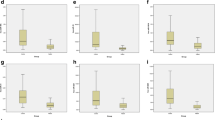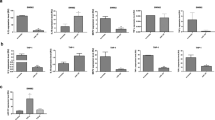Abstract
Objectives
Familial Mediterranean Fever (FMF) is the most common hereditary autoinflammatory disorder characterized by recurrent fever and serositis episodes. Identification of low penetrant or heterozygous MEFV mutations in clinically diagnosed FMF patients did raise a concern on whether epigenetic or environmental factors play an additional role in FMF pathogenesis. We aimed to investigate the expression profile of apoptosis-related miRNAs in FMF and their influence on clinical manifestations in the present study.
Method
191 pediatric FMF patients and 31 healthy children included in the study. Expressions of 33 apoptosis-related, circulating cell-free miRNAs were evaluated by a quantitative polymerase chain reaction, statistically calculated within ΔΔCt values and fold changes were evaluated by Welch T test, in which p < 0.05 were considered to be significant.
Results
Nineteen miRNAs, including let-7a-5p, let-7c, let-7 g-5p, miR-15b-5p, miR-16-5p, miR-17-5p, miR-23a-3p, miR-24-3p, miR-25-3p, miR-26a-5p, miR-26b-5p, miR-27a-3p, miR-29c-3p, miR-30a-5p, miR-30d-5p, miR-30e-5p, miR-106b-5p, miR-146a-5p, and miR-195-5p, were found down-regulated; miR-15a-5p, miR-29b-3p, miR-181a-5p, miR-181b-5p, miR-181c-5p, miR-214-3p, and miR-365a-3p were up-regulated in FMF patients. In detail, these miRNAs were similar among FMF patients in terms of genotype, colchicine response, and having an inflammatory attack during analysis.
Conclusion
We found that 26 apoptosis-related circulating miRNAs were deregulated in children with FMF. Thus, we speculate that these miRNAs have a role in FMF pathogenesis via apoptotic mechanisms.
Similar content being viewed by others
References
Ben-Chetrit E, Touitou I (2009) Familial Mediterranean fever in the world. Arthritis Rheum 61:1447–1453. https://doi.org/10.1002/art.24458
Tunca M, Akar S, Onen F, Ozdogan H, Kasapcopur O, Yalcinkaya F, Tutar E, Ozen S, Topaloglu R, Yilmaz E, Arici M, Bakkaloglu A, Besbas N, Akpolat T, Dinc A, Erken E, Turkish FMF Study Group (2005) Familial Mediterranean fever (FMF) in Turkey: results of a nationwide multicenter study. Medicine (Baltimore) 84(1):11. https://doi.org/10.1097/01.md.0000152370.84628.0c
Kisla Ekinci RM, Balci S, Dogruel D, Altintas DU, Yilmaz M (2019) Twenty-year experience of a single referral center on pediatric familial Mediterranean fever: what has changed over the last decade? J Clin Rheumatol. https://doi.org/10.1097/RHU.0000000000001146
Hentgen V, Grateau G, Kone-Paut I, Livneh A, Padeh S, Rozenbaum M, Amselem S, Gershoni-Baruch R, Touitou I, Ben-Chetrit E (2013) Evidence-based recommendations for the practical management of familial Mediterranean fever. Semin Arthritis Rheum 43:387–391. https://doi.org/10.1016/j.semarthrit.2013.04.011
Kasifoglu T, Bilge SY, Sari I, Solmaz D, Senel S, Emmungil H, Kilic L, Oner SY, Yildiz F, Yilmaz S, Bakirli DE, Tufan MA, Yilmaz S, Yazisiz V, Pehlivan Y, Bes C, Cetin GY, Erten S, Gonullu E, Temel T, Sahin F, Akar S, Aksu K, Kalyoncu U, Direskeneli H, Erken E, Kisacik B, Sayarlioglu M, Korkmaz C (2014) Amyloidosis and its related factors in Turkish patients with familial Mediterranean fever: a multicentre study. Rheumatology (Oxford) 53:741–745. https://doi.org/10.1093/rheumatology/ket400
Ait-Idir D, Djerdjouri B, Bouldjennet F, Taha RZ, El-Shanti H, Sari-Hamidou R, Khellaf G, Benmansour M, Benabadji M, Haddoum F (2017) The M694I/M694I genotype: a genetic risk factor of AA-amyloidosis in a group of Algerian patients with familial Mediterranean fever. Eur J Med Genet 60:149–153. https://doi.org/10.1016/j.ejmg.2016.12.003
The International FMF Consortium (1997) Ancient missense mutations in a new member of the RoRet gene family are likely to cause familial Mediterranean fever. Cell 90:797–807. https://doi.org/10.1016/s0092-8674(00)80539-5
French FMF Consortium (1997) A candidate gene for familial Mediterranean fever. Nat Genet 17:25–31. https://doi.org/10.1038/ng0997-25
Manukyan G, Aminov R (2016) Update on pyrin functions and mechanisms of familial Mediterranean fever. Front Microbiol 7:456. https://doi.org/10.3389/fmicb.2016.00456
Álvarez-Errico D, Vento-Tormo R, Ballestar E (2017) Genetic and epigenetic determinants in autoinflammatory diseases. Front Immunol 8:318. https://doi.org/10.3389/fimmu.2017.00318
Lee RC, Feinbaum RL, Ambros V (1993) The C. elegans heterochronic gene lin-4 encodes small RNAs with antisense complementarity to lin-14. Cell 75:843–854. https://doi.org/10.1016/0092-8674(93)90529-y
Reinhart BJ, Slack FJ, Basson M, Pasquinelli AE, Bettinger JC, Rougvie AE, Horvitz HR, Ruvkun G (2000) The 21-nucleotide let-7 RNA regulates developmental timing in Caenorhabditis elegans. Nature 403:901–906. https://doi.org/10.1038/35002607
Saliminejad K, Khorram Khorshid HR, Soleymani Fard S, Ghaffari SH (2019) An overview of microRNAs: biology, functions, therapeutics, and analysis methods. J Cell Physiol 234:5451–5465. https://doi.org/10.1002/jcp.27486
Ambros V (2004) The functions of animal microRNAs. Nature 431:350–355. https://doi.org/10.1038/nature02871
Latsoudis H, Mashreghi MF, Grün JR, Chang HD, Stuhlmüller B, Repa A, Gergiannaki I, Kabouraki E, Vlachos GS, Häupl T, Radbruch A, Sidiropoulos P, Doukoumetzidis K, Kardassis D, Niewold TB, Boumpas DT, Goulielmos GN (2017) Differential expression of miR-4520a associated with pyrin mutations in familial Mediterranean fever (FMF). J Cell Physiol 232:1326–1336. https://doi.org/10.1002/jcp.25602
Koga T, Migita K, Sato T, Sato S, Umeda M, Nonaka F, Fukui S, Kawashiri SY, Iwamoto N, Ichinose K, Tamai M, Nakamura H, Origuchi T, Ueki Y, Masumoto J, Agematsu K, Yachie A, Yoshiura KI, Eguchi K, Kawakami A (2018) MicroRNA-204-3p inhibits lipopolysaccharide-induced cytokines in familial Mediterranean fever via the phosphoinositide 3-kinase γ pathway. Rheumatology (Oxford) 57:718–726. https://doi.org/10.1093/rheumatology/kex451
Wada T, Toma T, Matsuda Y, Yachie A, Itami S, Taguchi YH, Murakami Y (2017) Microarray analysis of circulating microRNAs in familial Mediterranean fever. Mod Rheumatol 27:1040–1046. https://doi.org/10.1080/14397595.2017.1285845
Akkaya-Ulum YZ, Balci-Peynircioglu B, Karadag O, Eroglu FK, Kalyoncu U, Kiraz S, Ertenli AI, Özen S, Yilmaz E (2017) Alteration of the microRNA expression profile in familial Mediterranean fever patients. Clin Exp Rheumatol 35(Suppl 108):90–94
Hortu HO, Karaca E, Sozeri B, Gulez N, Makay B, Gunduz C, Atik T, Tekin IM, Unsal SE, Cogulu O (2019) Evaluation of the effects of miRNAs in familial Mediterranean fever. Clin Rheumatol 38(3):635–643. https://doi.org/10.1007/s10067-017-3914-0
Amarilyo G, Pillar N, Ben-Zvi I, Weissglas-Volkov D, Zalcman J, Harel L, Livneh A, Shomron N (2018) Analysis of microRNAs in familial Mediterranean fever. PLoS ONE 13:e0197829. https://doi.org/10.1371/journal.pone.0197829
Demir F, Çebi AH, Kalyoncu M (2020) Assessment of circulating microribonucleic acids in patients with familial Mediterranean fever. Arch Rheumatol. https://doi.org/10.5606/ArchRheumatol.2020.7414
de Jesus AA, Canna SW, Liu Y, Goldbach-Mansky R (2015) Molecular mechanisms in genetically defined autoinflammatory diseases: disorders of amplified danger signaling. Annu Rev Immunol 33:823–874. https://doi.org/10.1146/annurev-immunol-032414-112227
Park YH, Wood G, Kastner DL, Chae JJ (2016) Pyrin inflammasome activation and RhoA signaling in the autoinflammatory diseases FMF and HIDS. Nat Immunol 17:914–921. https://doi.org/10.1038/ni.3457
Xu H, Yang J, Gao W, Li L, Li P, Zhang L, Gong YN, Peng X, Xi JJ, Chen S, Wang F, Shao F (2014) Innate immune sensing of bacterial modifications of Rho GTPases by the pyrin inflammasome. Nature 513:237–241. https://doi.org/10.1038/nature13449
Martinon F, Hofmann K, Tschopp J (2001) The pyrin domain: a possible member of the death domain-fold family implicated in apoptosis and inflammation. Curr Biol 11:118–120. https://doi.org/10.1016/s0960-9822(01)00056-2
Richards N, Schaner P, Diaz A, Stuckey J, Shelden E, Wadhwa A, Gumucio DL (2001) Interaction between pyrin and the apoptotic speck protein (ASC) modulates ASC-induced apoptosis. J Biol Chem 276:39320–39329. https://doi.org/10.1074/jbc.M104730200
Gumucio DL, Diaz A, Schaner P, Richards N, Babcock C, Schaller M, Cesena T (2002) Fire and ICE: the role of pyrin domain-containing proteins in inflammation and apoptosis. Clin Exp Rheumatol 20:45–53
Kashyap D, Tuli HS, Garg VK, Goel N, Bishayee A (2018) Oncogenic and tumor-suppressive roles of MicroRNAs with special reference to apoptosis: molecular mechanisms and therapeutic potential. Mol Diagn Ther 22:179–201. https://doi.org/10.1007/s40291-018-0316-1
Pathak S, McDermott M, Savic S (2016) Autoinflammatory diseases: update on classification diagnosis and management. J Clin Pathol 70:1–8. https://doi.org/10.1136/jclinpath-2016-203810
Ozen S, Demirkaya E, Erer B, Livneh A, Ben-Chetrit E, Giancane G, Ozdogan H, Abu I, Gattorno M, Hawkins PN, Yuce S, Kallinich T, Bilginer Y, Kastner D, Carmona L (2016) EULAR recommendations for the management of familial Mediterranean fever. Ann Rheum Dis 75:644–651. https://doi.org/10.1136/annrheumdis-2015-208690
Huang Z, Xu Y, Peng W (2015) Colchicine induces apoptosis in HT-29 human colon cancer cells via the AKT and c-Jun N-terminal kinase signaling pathways. Mol Med Rep 12:5939–5944. https://doi.org/10.3892/mmr.2015.4222
Chen XM, Liu J, Wang T, Shang J (2012) Colchicine-induced apoptosis in human normal liver L-02 cells by mitochondrial mediated pathways. Toxicol In Vitro 26:649–655. https://doi.org/10.1016/j.tiv.2012.01.024
Balci-Peynircioglu B, Akkaya-Ulum YZ, Akbaba TH, Tavukcuoglu Z (2019) Potential of miRNAs to predict and treat inflammation from the perspective of familial Mediterranean fever. Inflamm Res 68:905–913. https://doi.org/10.1007/s00011-019-01272-6
Siegel RM, Fleisher TA (1999) The role of Fas and related death receptors in autoimmune and other disease states. J Allergy Clin Immunol 103:729–738. https://doi.org/10.1016/s0091-6749(99)70412-4
Shiohara M, Taniguchi S, Masumoto J, Yasui K, Koike K, Komiyama A, Sagara J (2002) ASC, which is composed of a PYD and a CARD, is up-regulated by inflammation and apoptosis in human neutrophils. Biochem Biophys Res Commun 293:1314–1318. https://doi.org/10.1016/S0006-291X(02)00384-4
Ozen S, Uckan D, Baskin E, Besbas N, Okur H, Saatci U, Bakkaloglu A (2001) Increased neutrophil apoptosis during attacks of familial Mediterranean fever. Clin Exp Rheumatol 19:68–71
Ceri M, Unverdi S, Senes M, Altay M, Yilmaz R, Yucel D, Duranay M (2013) Serum soluble fas ligand levels in familial Mediterranean fever. Ren Fail 35:835–857. https://doi.org/10.3109/0886022X.2013.794660
Davtyan TK, Harutyunyan VA, Hakobyan GS, Avetisyan SA (2008) Heightened endotoxin susceptibility of monocytes and neutrophils during familial Mediterranean fever. FEMS Immunol Med Microbiol 52:370–378. https://doi.org/10.1111/j.1574-695X.2008.00385.x
Manukyan G, Aminov R, Hakobyan G, Davtyan T (2015) Accelerated apoptosis of neutrophils in familial Mediterranean fever. Front Immunol 6:239. https://doi.org/10.3389/fimmu.2015.00239
Liu B, Guo Z, Gao W (2019) miR-181b-5p promotes proliferation and inhibits apoptosis of hypertrophic scar fibroblasts through regulating the MEK/ERK/p21 pathway. Exp Ther Med 17:1537–1544. https://doi.org/10.3892/etm.2019.7159
Wang X, Li Z, Bai J, Song W, Zhang F (2019) miR-17-5p regulates the proliferation and apoptosis of human trabecular meshwork cells by targeting phosphatase and tensin homolog. Mol Med Rep 19:3132–3138. https://doi.org/10.3892/mmr.2019.9973
Sárközy M, Kahán Z, Csont T (2018) A myriad of roles of miR-25 in health and disease. Oncotarget 9:21580–21612. https://doi.org/10.18632/oncotarget.24662
Zheng C, Zheng Z, Sun J, Zhang Y, Wei C, Ke X, Liu Y, Deng L, Wang H (2017) MiR-16-5p mediates a positive feedback loop in EV71-induced apoptosis and suppresses virus replication. Sci Rep 7:16422. https://doi.org/10.1038/s41598-017-16616-7
Zhao DL, Wu QL (2019) Effect of inhibition to Yes-related proteins-mediated Wnt/β-catenin signaling pathway through miR-195-5p on apoptosis of gastric cancer cells. Eur Rev Med Pharmacol Sci 23:6486–6496. https://doi.org/10.26355/eurrev_201908_18532
Acknowledgements
We specially thank to Aidan Boga (Brisbane, Australia) for his excellent work on language editing of the paper.
Funding
This work was supported by the grants from the Cukurova University Scientific Research Projects Coordination Unit (TTU-2017-7994), Adana, Turkey.
Author information
Authors and Affiliations
Contributions
Dr. Karpuzoglu and Dr. Yilmaz conceptualized and designed the study, drafted the initial manuscript, and reviewed and revised the manuscript. Dr. Kisla Ekinci, Dr. Bisgin, and Dr. Balci collected data carried out the initial analyses, and critically reviewed and revised the manuscript. All authors approved the final manuscript as submitted and agreed to be accountable for all aspects of the work. All co-authors take full responsibility for the integrity of the study.
Corresponding author
Ethics declarations
Conflict of interest
Authors declare that they have no conflicts of interest. All co-authors take full responsibility for the integrity of the study.
Ethical approval
All procedures performed in studies involving human participants were in accordance with the ethical standards of the institutional and/or national research committee and with the 1964 Helsinki Declaration and its later amendments or comparable ethical standards.
Informed consent
Informed consent was obtained from parents of the participants included in the study.
Additional information
Publisher's Note
Springer Nature remains neutral with regard to jurisdictional claims in published maps and institutional affiliations.
Rights and permissions
About this article
Cite this article
Karpuzoglu, E.M., Kisla Ekinci, R.M., Balci, S. et al. Altered expression of apoptosis-related, circulating cell-free miRNAs in children with familial Mediterranean fever: a cross-sectional study. Rheumatol Int 41, 103–111 (2021). https://doi.org/10.1007/s00296-020-04541-4
Received:
Accepted:
Published:
Issue Date:
DOI: https://doi.org/10.1007/s00296-020-04541-4




